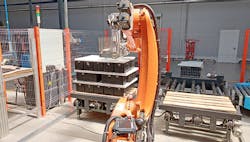Robotic applications have been most successful in operations where the same precise actions are repeatedly performed. In these cases, the robot is not required to sense change in its environment and act accordingly to complete the task.
Robots were considered ideal for jobs that were dirty, dull or dangerous, but investment was high, not only for the robots, but the processes needed to upgrade automation that adapts to dynamic workflows.
Distribution centers (DCs), conversely, are characterized by constant change. Logistic tasks are unpredictable and inexact, and they frequently aren’t repeatable, like many manufacturing or assembly processes. For example, the same combination of items may never be ordered by any other customer, or the DC may have switched to a different type of packaging by the time the same items are reordered.
DCs also create other unique challenges for automation. Inventories are more massive and diverse than ever before. The ability to give consumers exactly what they want when they want it is a huge competitive differentiator.
Work smarter with robotic intelligence
A new generation of robots designed specifically for DCs has been made possible by advances in five key technologies:
- sensors and vision
- machine learning (ML) and artificial intelligence (AI)
- connectivity
- mobility
- computing power.
Sensors and vision
Robots are far more aware of their environments. Various sensor technologies—including 3D imaging, high-resolution optical cameras, light detection and ranging (lidar) and various force-sensing methods—provide new ways to perceive and interact with their surroundings safely.
ML and AI
These two powerful technologies enable robots to perform advanced problem-solving on their own while allowing humans to stay in the loop for training operations. ML and AI solutions are highly dependent on the data captured from robotic operations, later employing the data to allow the robot to help make decisions in future operations. This helps robotic operation to create its own level of intelligence.
Connectivity
By harnessing the power of the cloud and sensory data pipelines, advanced connectivity features provide meaningful performance advantages and reduce operator interventions. Over time, connectivity creates a valuable conduit to operational data which helps to identify opportunities and focus areas for ongoing enhancements.
Mobility
Mobile robots are among the fastest-growing automation solutions within DCs. They offer cost-effective automation on demand and can be deployed quickly with minimal IT or infrastructure changes. Integrated sensors provide the data needed to navigate a DC while avoiding obstacles and rerouting when necessary. Fully integrated software solutions for planning, routing and managing the flow of a fleet of mobile robots enable optimal utilization and adapt to minor day-to-day operational variations.
Computing power
The newest generation of computing has been designed with significant processing power, enabling superior performance in every robotic aspect, from computer vision to motion and grasp planning. Robots can also use advanced, physics-based simulation and training capabilities to learn faster. This allows robotic solutions to be more robust in the real world, further reducing the risks of deployment and achieving faster return on investment.
Palletizing and depalletizing
Palletizing and depalletizing are demanding, repetitive and injury-prone tasks; DC operators often face labor shortages and high turnover rates.
Depalletizing various single-SKU pallets without pre-programmed stacking patterns or more complicated tasks such as mixed-SKU depalletizing have traditionally been challenging to automate. These capabilities are now a reality for the latest generation of depalletizing robots, thanks to advances in perception, ML and gripping technologies.
Capable of sensing single- or mixed-SKU stacking patterns without pre-programming, smart flexible depalletizing robots can handle cases ranging in size from a small tissue box to a microwave oven. This solution significantly reduces labor costs and injuries by potentially shifting three to four full-time equivalents per robot out of the depalletizing operation.
Also read: Autonomous mobile robots’ value is more than just speed
Additionally, it creates flexibility in your DC operation, handling a continuous flow of mixed-SKU or single-SKU pallets in any sequence.
For maximum flexibility in the smallest possible footprint, the depalletizing robot can work in conjunction with pallet-conveyance autonomous mobile robots, enabling continuous operation of the system while providing the flexibility to stage pallets and empty stacks virtually anywhere the robot is capable of traveling.
Autonomous mobile robots
Transport workflows tie up significant labor in many manual DC operations. By reducing walk and vehicle drive times, autonomous mobile robots (AMRs) enable operators to transport products and deploy workers in the most efficient manner.
Mobile robotics have already proven their value in a variety of DC-related jobs.
• Pallet conveyance: AMRs are capable of transporting sizeable pallet loads and can be loaded or unloaded by interfacing to pickup and delivery stations.
• Cart transport: By automating the movement of rolling carts, AMRs streamline picking or cart transporting operations, eliminating errors and freeing up scarce workers for more value-added tasks.
• Machine tending/replenishment: AMRs with roller tops can be used to transport goods to and from an automated storage and retrieval system (AS/RS) or handle items that can’t easily be moved by traditional conveyors. They can also provide a flexible bridge between different conveyor systems within a facility.
For increased accuracy and operational flexibility, AMRs can be combined with order-picking technologies like hand scanners or voice systems.
AS/RS
This flexible and highly scalable solution has the capacity to pick cases and other containers from storage, transferring them onto complementary automation systems or to picking stations for fulfilling orders. More configurable than traditional systems, robotic solutions can accommodate a wide range of products and save valuable warehouse space by increasing the density of product storage. Robotics also offer a viable solution in some situations where an AS/RS doesn’t fit the needs of the operation.
The system can be implemented quickly, even with existing workflows, and easily integrates with traditional and mobile automation solutions.
Thomas Evans is robotics chief technology officer at Honeywell. Contact him at [email protected].
About the Author
Thomas Evans
Honeywell

Leaders relevant to this article:

